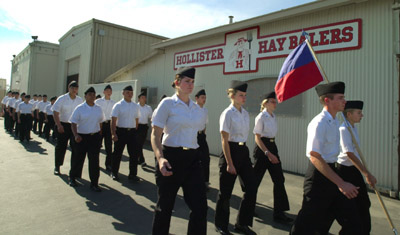Students at San Benito High School have started marching to a
different beat.
Nearly 200 students have enrolled in the high school’s Naval
Junior Reserve Officers Training Corps program as a popular
alternative to fulfill 20 units of physical education requirements
for graduation. The class can also fulfill elective units.
And in its first year, the program is in high demand.
Students at San Benito High School have started marching to a different beat.
Nearly 200 students have enrolled in the high school’s Naval Junior Reserve Officers Training Corps program as a popular alternative to fulfill 20 units of physical education requirements for graduation. The class can also fulfill elective units.
And in its first year, the program is in high demand.
“I signed up for the class because I wanted to try something new and exciting,” said sophomore Esmeralda Bernal.
Junior Linda Flores has already taken her required two years of physical education, and is interested in joining the U.S. Navy. She decided to take the class because it would give her an idea of what the military is like.
SBHS offers 10 Naval Science 1 classes taught by two instructors – Lt. Cmdr. Larry Chizek and Chief Bill Stratmann, both retired U.S. Navy personnel.
Chizek said 40 percent of SBHS’ cadets are female and 60 percent are male, both on par with the program’s national rate.
Approximately 40 percent of all Naval Junior ROTC program graduates enter military service after high school, and minority participation is 59 percent.
However, students enrolled in the class are not obligated to join the military.
“Naval Junior ROTC encourages students to be successful in life, whether it’s going to college or getting a job or going into the military,” Chizek said.
Superintendent Dick Lowry said the program’s focus is not to recruit students.
“The program is popular. It’s appropriate to students who are not involved in other activities,” Lowry said. “Its focus is on developing citizenship and responsibility.”
Chizek said there are two main reasons students participate in the program.
“One, it’s kind of a taste of what the military is like. They can see if they enjoy it,” he said. “Two, it’s meant to help students become good citizens, patriotic, and be self-disciplined.”
Junior Kyle Galien said he signed up for the class because he wanted to improve his self-discipline.
“I thought it was going to teach me a lot of discipline and communication and leadership skills,” he said. “It’s fun to hang out with other military people.”
Students, who are considered cadets, are given four uniforms – summer blues, working khakis, winter blues and an officer’s uniform. The U.S. Navy provides all of the uniforms while students provide black socks and white underwear, Chizek said.
Once a week, students wear their officer’s uniform all day. From their shined shoes to their crisp shirts, the cadets stand out on campus.
Galien said he receives a lot of positive reactions when wearing his uniform around school. Even football players have complimented him, he said.
Each class of about 20 cadets is divided into a hierarchy structure with executive officers, platoon commanders and more. Each class is considered a platoon and the two classes offered that period are combined to form a company.
Beyond the class, there are extracurricular teams or clubs. These are separated into an academic, a color guard, an honor guard, an orienteering, an athletic and a drill-marching team. Teams meet before or after school.
Cadets can also earn ribbons in categories like participation and physical fitness.
And the Navy Junior ROTC program will expand in the coming years. Currently, there are four classes in the Naval Science curriculum (1-4), but next year the program will offer Naval Science 1 and 2, and so on.
Depending on how many of the four classes a student participates in, they can enter the military as an E3 instead of an E1, which means higher pay and faster advancement, Chizek said.
All five branches of the military have Junior ROTC programs, but the U.S. Navy was the most responsive to SBHS’ desire to have a Junior ROTC program on campus.
Chizek said he was surprised by how many students showed interest in the program beyond just the exercise. Students learn leadership and job training skills, he said.
Also, Naval Junior ROTC students are taught naval science, military drill, the military rank structure and how to wear a uniform.
Chizek said he is pleased with the start of the program, but there is room for improvement.
“I’m happy,” he said. “It was a major accomplishment to get everyone in uniform. It’s been tough and there’s still a long way to go. But, every time you start new, you’re on a learning curve.”
The cadets have already participated in Homecoming and Veteran’s Day ceremonies this year. In early February, Chizek said he would like to have students participating in competitions with other local schools in Monterey and San Jose.
A parent booster club is working to help raise money so students can enter the competitions.
For more information about the Navy Junior ROTC program, call Larry Chizek at 637-5831, ext. 304. For more information on the parent booster club or to donate funds, call John Lisius at 637-7877.










